|
|
ENVIS Technical Report: 104, March 2016 |
 |
DEVARABISANAHALLI LAKE: PATH TOWARDS ECOLOGICAL RESTORATION
|
 |
Ramachandra T.V.
Vinay .S
Sincy .V
Asulabha .K.S
Sudarshan .P. Bhat
Bharath H. Aithal
Energy and Wetlands Research Group, Centre for Ecological Sciences, Indian Institute of Science, Bangalore – 560012, India.
*Corresponding author: cestvr@ces.iisc.ac.in
Citation: Ramachandra T V, Vinay S, Sincy V, Asulabha K S, Sudarshan Bhat and Bharath H.Aithal, 2016.Devarabisanahalli Lake: Path towards Ecological restoration, ENVIS Technical Report 104, Energy & Wetlands Research Group, CES, IISc, Bangalore, India
|
PHYSICO-CHEMICAL STATUS OF DEVARABISANAHALLI LAKE
|
Devarabisanahalli Lake with an area of 5.57 hectare is located near Intel office and Adarsh Palm Retreat apartments in Bellandur Ward (south-east Bangalore).
 Devarabisanahalli Lake Devarabisanahalli Lake |
 Construction activities near the lake Construction activities near the lake
|
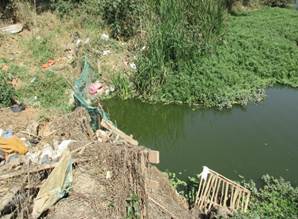 Outlet of the lake Outlet of the lake
|
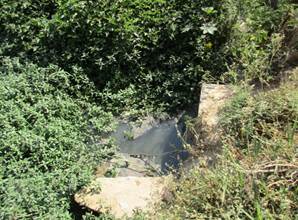 Inlet to the lake
Inlet to the lake
|
 People bathing in lake water People bathing in lake water
|
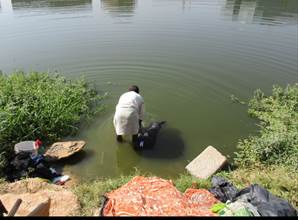 Washing activities by dhobis Washing activities by dhobis
|
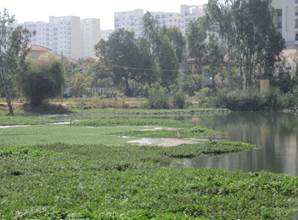
Profuse growth of macrophytes in the lake
|
Figure 1: DEVARABISANAHALLI Lake
The water samples were collected for physico-chemical analysis from six different sites of DEVARABISANAHALLI Lake (figure 2).
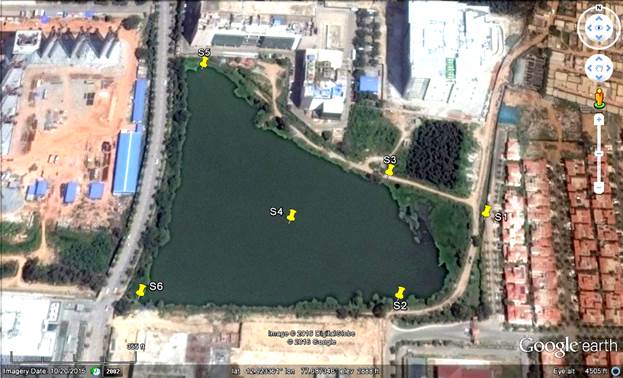 Figure 2: DEVARABISANAHALLI Lake
Figure 2: DEVARABISANAHALLI Lake
The site 1 is the treatment plant water, site 2 is inlet to the lake, site 3 and site 5 near to Honey Well side, site 4 is at the centre of the lake, and site 6 is outlet of the lake (figure 2).
Physico-chemical Analysis: The analysis of physico-chemical parameters like water temperature (WT); pH; total dissolved solids (TDS); electrical conductivity (EC); dissolved oxygen (DO); chemical oxygen demand (COD); biochemical oxygen demand (BOD); total alkalinity (TA); chloride (Cl); total hardness (TH); calcium hardness (CaH); magnesium hardness (MgH); nitrate; orthophosphate (OP); sodium (Na) and potassium (K) of water samples collected from Devarabisanahalli Lake were done according to the standard procedures by APHA AWWA WEF (1998) and Trivedy Goel (1986).
Table 1: Standard methods followed for water quality analysis
Parameters |
Methods (with Reference) |
Onsite Measurements |
Water temperature (0C) |
Eutech: PCSTestr 35 |
pH |
Eutech: PCSTestr 35 |
Total Dissolved Solids (TDS, mg/l) |
Eutech: PCSTestr 35 |
Electrical conductivity (µS/cm) |
Eutech: PCSTestr 35 |
Dissolved Oxygen (DO) (mg/l) |
Winkler’s Method (APHA, 1998: 4500-O) |
Laboratory Measurements |
Hardness (mg/l) |
EDTA titrimetric method (APHA, 1998: 2340-C) |
Calcium hardness (mg/l) |
EDTA titrimetric method (APHA, 1998: 3500-Ca B) |
Magnesium hardness (mg/l) |
Magnesium by calculation (APHA, 1998:3500-Mg) |
Sodium (mg/l) |
Flame emission photometric method (APHA, 1998:3500-Na B) |
Potassium (mg/l) |
Flame emission photometric method (APHA, 1998: 3500-K B) |
Alkalinity (mg/l) |
Titrimetric method (APHA, 1998: 2320 B) |
Chloride (mg/l) |
Argentometric method (APHA, 1998:4500-Cl- B) |
Biochemical Oxygen Demand (BOD) (mg/l) |
5-Day BOD test (APHA, 5210 B, Trivedi & Goel, 1986, pp.53-55) |
Chemical Oxygen Demand (COD) (mg/l) |
Closed reflux, titrimetric method (APHA, 5220 C, Trivedi & Goel, 1986, pp.55-57) |
Nitrate (mg/l) |
Phenol Disulphonic acid method (Trivedy & Goel, 1986: pp 61) |
Orthophosphate (mg/l) |
Stannous chloride method (APHA, 4500-P) |
RESULTS AND DISCUSSIONS
pH of the water samples was found to be highly alkaline (8.21 – 9.08). High levels of TDS and EC indicate pollution. pH increases due to photosynthesis (uptake of carbon-dioxide with the release of oxygen to water) by phytoplankton. The higher amount of ions such as calcium, magnesium, sodium, chloride, sulphates, nitrate, bicarbonates and carbonates in water contributes to high total dissolved solids and electrical conductivity. The high concentration of sodium and potassium also indicates sewage contamination. Higher turbidity of lake water is due to the presence of silt, clay, organic and inorganic matter, planktonic organism etc. that makes water unfit for domestic and industrial purposes. The turbidity of the lake water, along with its warm temperature, alkaline pH and low oxygen levels lead to prolonged survival of pathogenic bacteria. It was found that the inlet sewage water entering the lake has comparatively higher amount of TDS, EC, Turbidity, BOD, COD, Alkalinity, Total hardness, Nutrients, Sodium and Potassium than the lake water (middle and outlet). Even though there is a high demand of oxygen in sewage water that enters the lake, the dissolved oxygen level in the lake is very high. The high nutrient contents had supported algal and macrophyte growth that had increased photosynthetic activities and oxygen levels in the lake. All the physico-chemical parameters of the lake water are within the permissible limits as per Indian standards (table 2). High sodium content makes lake water salty and unfit for use. The physico-chemical characteristics of Devarabisanahalli Lake indicate pollution/sewage entry into the lake and the lake falls under Class E as per CPCB standards (table 3).
Table 2: Physico-chemical characteristics of water collected from Devarabisanahalli lake
Parameters
|
DEVARABISANAHALLI |
Water quality Standard IS 10500, 1991-2011 |
|
S1 |
S2 |
S3 |
S4 |
S5 |
S6 |
Desirable |
Permissible |
Water Temperature (0C) |
28.6 |
24.5 |
24 |
26.8 |
26.4 |
23.3 |
- |
- |
TDS (mg/l) |
932 |
618 |
578 |
586 |
585 |
572 |
500 |
2000 |
EC (µS) |
1326 |
1025 |
910 |
945 |
909 |
905 |
- |
- |
pH |
8.21 |
7.65 |
8.96 |
9.07 |
9.08 |
9.03 |
6.5-8.5 |
No relaxation |
Turbidity(NTU) |
148 |
104.5 |
32.9 |
37.8 |
33.2 |
36.95 |
5 |
10 |
DO (mg/l) |
0 |
0 |
8.54 |
18.7 |
10 |
10.47 |
- |
- |
BOD (mg/l) |
65.04 |
40.65 |
16.26 |
10.16 |
14.23 |
12.2 |
- |
- |
COD (mg/l) |
96 |
56 |
24 |
16 |
20 |
20 |
- |
- |
Alkalinity (mg/l) |
437.33 |
382.67 |
325.33 |
348 |
318.67 |
322.67 |
200 |
600 |
Chloride (mg/l) |
328.02 |
204 |
225.78 |
223.89 |
218.68 |
223.89 |
250 |
1000 |
Total Hardness (mg/l) |
348 |
274 |
273.33 |
256.67 |
260 |
266 |
300 |
600 |
Ca Hardness (mg/l) |
64.66 |
75.08 |
74.01 |
69.47 |
71.34 |
74.01 |
75 |
200 |
Mg Hardness (mg/l) |
68.85 |
48.34 |
48.43 |
45.49 |
45.84 |
46.65 |
30 |
100 |
Phosphate (mg/l) |
1.7 |
1.148 |
1.139 |
0.884 |
1.374 |
1.094 |
- |
- |
Nitrate (mg/l) |
0.545 |
0.461 |
0.281 |
0.263 |
0.287 |
0.275 |
45 |
100 |
Sodium (mg/l) |
569.4 |
270.6 |
385.6 |
346.4 |
322.8 |
362.4 |
- |
- |
Potassium (mg/l) |
51.5 |
33 |
45.2 |
45.2 |
46 |
43.2 |
- |
- |
SEDIMENT Analysis: Sediment at the entry point of the lake has C=23.77% and N=2.38%
Table 3: Classification of Inland Surface Water (CPCB)
As per ISI-IS: 2296-1982 |
Classification |
Type of use |
Class A |
Drinking water source without conventional treatment but after disinfection |
Class B |
Outdoor bathing |
Class C |
Drinking water source with conventional treatment followed by disinfection. |
Class D |
Fish culture and wild life propagation |
Class E |
Irrigation, industrial cooling or controlled waste disposal |
Characteristic |
A |
B |
C |
D |
E |
pH |
6.5 - 8.5 |
6.5 - 8.5 |
6.5 - 8.5 |
6.5 - 8.5 |
6.0 - 8.5 |
DO (mg/L) |
6 |
5 |
4 |
4 |
- |
BOD (mg/L) |
2 |
3 |
3 |
- |
- |
TDS, mg/l, Max |
500 |
- |
1500 |
- |
2100 |
Electrical Conductance at 25 °C, µS, Max |
- |
- |
- |
1000 |
2250 |
Total Hardness (as CaCO3), mg/l, Max |
300 |
- |
- |
- |
- |
Calcium Hardness (as CaCO3), mg/l, Max |
200 |
- |
- |
- |
- |
Magnesium Hardness (as CaCO3), mg/l, Max |
100 |
- |
- |
- |
- |
Chlorides (as Cl), mg/l, Max |
250 |
- |
600 |
- |
600 |
Nitrates (as NO2), mg/1, Max |
20 |
- |
50 |
- |
- |
RECOMMENDATIONS TO SUSTAIN GROUNDWATER IN THE REGION
Devarabisanahalli Lake include:
- Ensure proper fencing of Devarabisanahalli lake (after mapping of lake boundary)
- Any alteration of topography in lake catchments should be banned
- Maintenance of 30 m buffer around the lake (with regulated activities)
- Threshold on high raise building in the region. Need to protect valley zones considering ecological function and these regions are ‘NO DEVELOPMENT ZONES’ as per CDP 2005, 2015
-
Complete ban on construction activities in the valley zones and removal of all encroachments in the lake bed
-
Restrictions on dumping solid and liquid wastes into lakes (i.e. letting untreated sewage into lakes)
-
Allowing only treated wastewater (sewage and effluents) into the lake
-
Implementation of ‘polluter pays’ principle as per water act 1974
-
Dredging of sediments in the lake to improve the soil permeability, water holding capacity and ground water recharge.
-
Regular harvesting/removal of macrophytes in the lakes like Eichhornia sp., Typha sp., Alternanthera sp. etc. through manual operations.
-
Treatment of wastewater through constructed wetlands and algal ponds will help in the removal of nutrients (as in Jakkur model).
-
Ensure that STPs in lake are functioning properly.
-
Environmental awareness programmes can greatly help in the protection of the water bodies.
References:
-
APHA, Standard Methods (20 Ed.) for the examination of water and waste water, APHA, AWWA, WPCE, Washington DC, 1998.
-
BIS, Drinking Water Specification IS: 10500: 1991. First Revision, Bureau of Indian Standards, India, 1992.
-
Ramachandra, T. V., Mahapatra, D. M., Bhat, S. P., Asulabha, K. S., Sincy, V., and Aithal, B. H., Integrated wetlands ecosystem: Sustainable model to mitigate water crisis in Bangalore. ENVIS Technical Report 76, Environmental Information System, CES, Indian Institute of Science, Bangalore, 2014
-
Ramachandra, T. V., Aithal, B. H., Vinay, S., Setturu, B., Asulabha, K. S., Sincy, V., and Bhat, S. P., Vanishing lakes interconnectivity and violations in valley zone: Lack of co-ordination among para-state agencies, ENVIS Technical Report 85, CES, Indian Institute of Science, Bangalore, 2015.
-
Ramachandra,T. V., Asulabha, K. S., Aithal, B. H., Settur, B., Mahapatra, D. M., Kulkarni, G., Bhat, H., R., Sincy V., Bhat, S. P., Vinay, S., Environment monitoring in the neighbourhood, ENVIS Technical Report 77, Environmental Information System, CES, Indian Institute of Science, Bangalore, 2014.
-
Ramachandra, T. V., Asulabha, K. S., Sincy, V., and Bhat, S. P., Agony of Chikkabettahalli lake, Vidyaranyapura, Bruhat Bangalore. ENVIS Technical Report 83, Environmental Information System, CES, Indian Institute of Science, Bangalore, 2014.
-
Ramachandra, T. V., Asulabha, K. S., Sincy, V., Vinay, S., Bhat, S. P., and Aithal, B. H., Sankey Lake: Waiting for an immediate sensible action. ENVIS Technical Report 74, Environmental Information System, CES, Indian Institute of Science, Bangalore, 2015.
-
Ramachandra, T. V., Asulabha, K. S., Sincy, V., Vinay, S., Aithal, B. H., Bhat, S. P., and Mahapatra, D. M., Pathetic status of wetlands in Bangalore: Epitome of inefficient and uncoordinated Governance. ENVIS Technical Report 93, CES, Indian Institute of Science, Bangalore, 2015.
-
Trivedi, R. K., and Goel, P. K., Chemical and biological methods for water pollution studies. Published by Environmental Publications, Post Box 60, Karad, 1986.
-
http://bangalore.citizenmatters.in/blogs/like-a-lake/blog_posts/devarabisanahalli-lake-to-celebrate-world-wetlands-day?utm_source=copy
-
Ramachandra T.V., Durga Madhab Mahapatra, Sudarshan P. Bhat, Asulabha K.S., Sincy Varghese, Bharath H. Aithal, 2014. Integrated Wetlands Ecosystem: Sustainable Model to Mitigate Water Crisis in Bangalore, ENVIS Technical Report 76, Environmental Information System, CES, Indian Institute of Science, Bangalore 560012
-
Ramachandra T V, Asulabha K S, Sincy V, Sudarshan Bhat and Bharath H.Aithal, 2015. Wetlands: Treasure of Bangalore, ENVIS Technical Report 101, Energy & Wetlands Research Group, CES, IISc, Bangalore, India
|
|


 Devarabisanahalli Lake
Devarabisanahalli Lake Construction activities near the lake
Construction activities near the lake Outlet of the lake
Outlet of the lake Inlet to the lake
Inlet to the lake People bathing in lake water
People bathing in lake water Washing activities by dhobis
Washing activities by dhobis
